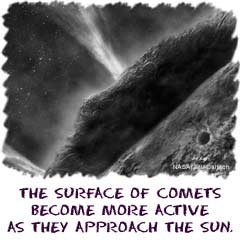|
|
||||||||||||||||||||||||||||
 |
|

|
||||||||||||||||||||||||||
Dirty Iceballs Comets are small chunks of ice and dirt that fly through systems in long, wild orbits. They are created when a planetary system develops. Nearly all comets orbit a star while asteroids may move through the galaxy as remnants from the creation of the universe. Comets are closely related to the formation of systems. They are left over pieces of frozen gases and water that were never absorbed by the forming planets.
Comets are small chunks of ice and dirt that fly through systems in long, wild orbits. They are created when a planetary system develops. Nearly all comets orbit a star while asteroids may move through the galaxy as remnants from the creation of the universe. Comets are closely related to the formation of systems. They are left over pieces of frozen gases and water that were never absorbed by the forming planets.
Comet OrbitsYou may know that planets move in elliptical orbits around their sun. An ellipse is a shape that is like a narrow circle. Comets move in very narrow and stretched out ellipses. They sometimes cross the orbits of several planets on their trip around their sun. Comets also have tails. Those tails are streams of gas and dust that follow the comets for thousands of miles. Comets aren't really on fire. The light you see is reflected light from the closest star. The light is reflected off the gases, ice, dirt, and dust that travel with the comet.Comet ClassificationEvery comet is special and unique. They each have distinct orbits around a star and a unique chemical makeup. Even though they are all different, scientists categorize them by how long it takes them to complete an orbit around the Sun. There are long-period comets and short-period comets. Long-period comets usually take over 200 years to orbit the Sun. Short-period comets make it around in less than 200. Halley's Comet is famous and orbits the Sun once every 76 years. Comet Kohoutek has a period of 75,000 years.Exploring CometsIn the same way that we send probes to look at other planets, we also spacecraft to study comets. In 2004, the Stardust mission encountered Comet Wild2 and collected samples. Astronomers hope to learn more about the origins of the Solar System and the universe from those particles. The most interesting compounds will be those that contain carbon because they may hold the keys to the origins of life. Comets could have hit the Earth millions of years ago and helped seed organic (carbon-based) life. The Deep Impact mission sent a projectile to collide with a comet. The spacecraft then analyzed the scattered dust and ice. |

|
|||||||||||||||||||||||||||
Useful Reference MaterialsEncyclopedia.com:http://www.encyclopedia.com/topic/Comets.aspx Encyclopedia.com (Halley's Comet): http://www.encyclopedia.com/topic/Halleys_comet.aspx Wikipedia: http://en.wikipedia.org/wiki/Comet Encyclopædia Britannica: http://www.britannica.com/EBchecked/topic/127524/comet | ||||||||||||||||||||||||||||
|
RETURN TO TOP or Search for more information... * The custom search only looks at Rader's sites. |
|||||||||||||||||||||||||||
©copyright 1997-2015 Andrew Rader Studios, All rights reserved. Current Page: Cosmos4Kids.com | Solar System Details | Comets |
||||||||||||||||||||||||||||
|
|
||||||||||||||||||||||||||||

